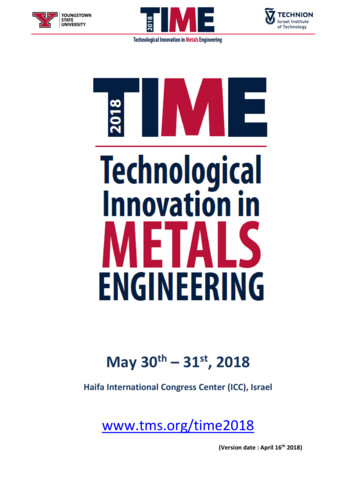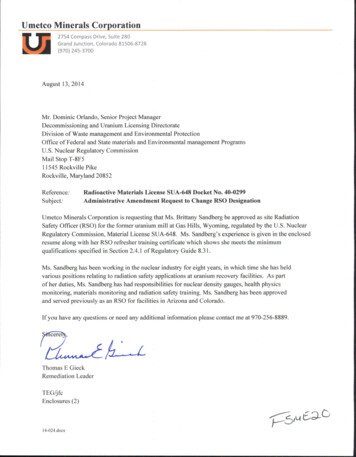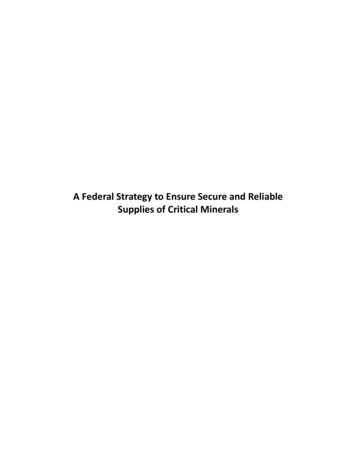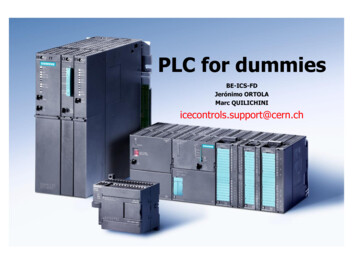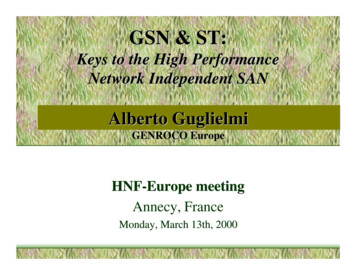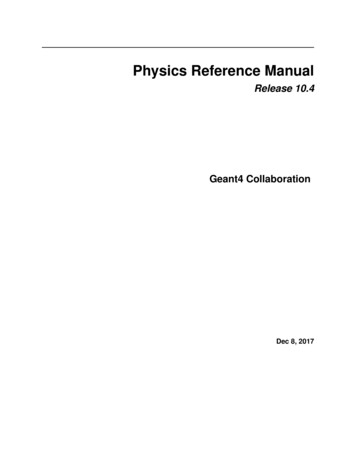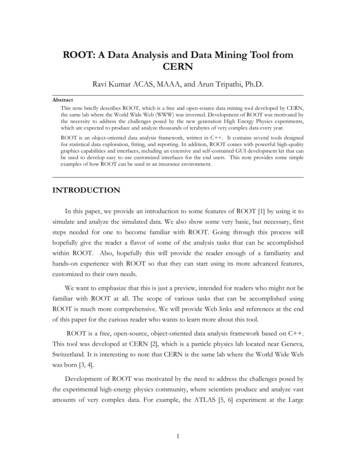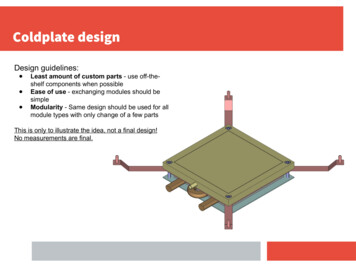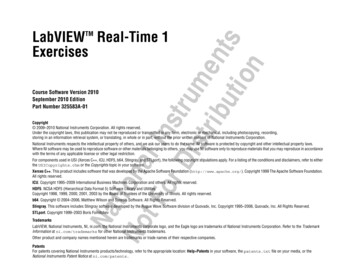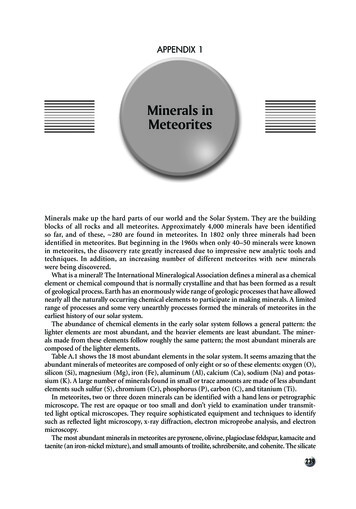
Transcription
APPENDIX 1Minerals inMeteoritesMinerals make up the hard parts of our world and the Solar System. They are the buildingblocks of all rocks and all meteorites. Approximately 4,000 minerals have been identifiedso far, and of these, 280 are found in meteorites. In 1802 only three minerals had beenidentified in meteorites. But beginning in the 1960s when only 40–50 minerals were knownin meteorites, the discovery rate greatly increased due to impressive new analytic tools andtechniques. In addition, an increasing number of different meteorites with new mineralswere being discovered.What is a mineral? The International Mineralogical Association defines a mineral as a chemicalelement or chemical compound that is normally crystalline and that has been formed as a resultof geological process. Earth has an enormously wide range of geologic processes that have allowednearly all the naturally occurring chemical elements to participate in making minerals. A limitedrange of processes and some very unearthly processes formed the minerals of meteorites in theearliest history of our solar system.The abundance of chemical elements in the early solar system follows a general pattern: thelighter elements are most abundant, and the heavier elements are least abundant. The minerals made from these elements follow roughly the same pattern; the most abundant minerals arecomposed of the lighter elements.Table A.1 shows the 18 most abundant elements in the solar system. It seems amazing that theabundant minerals of meteorites are composed of only eight or so of these elements: oxygen (O),silicon (Si), magnesium (Mg), iron (Fe), aluminum (Al), calcium (Ca), sodium (Na) and potassium (K). A large number of minerals found in small or trace amounts are made of less abundantelements such sulfur (S), chromium (Cr), phosphorus (P), carbon (C), and titanium (Ti).In meteorites, two or three dozen minerals can be identified with a hand lens or petrographicmicroscope. The rest are opaque or too small and don’t yield to examination under transmitted light optical microscopes. They require sophisticated equipment and techniques to identifysuch as reflected light microscopy, x-ray diffraction, electron microprobe analysis, and electronmicroscopy.The most abundant minerals in meteorites are pyroxene, olivine, plagioclase feldspar, kamacite andtaenite (an iron-nickel mixture), and small amounts of troilite, schreibersite, and cohenite. The silicate239
Field Guide to Meteors and Meteorites240Table A.1. The 18 most abundant elements in our solar system. Those elements shown in bold have combined to make the abundant minerals foundin meteorites and on EarthElement ChemicalElemental SymbolAbundance, No. of Abundance of each element is compared to one million atoms of silicon. Forexample, for every million atoms of silicon there are 3,692 atoms of potassium.aminerals—pyroxenes, olivines, and feldspars—dominate the stony meteorites. Metals—kamacite andtaenite—along with small amounts of schreibersite and cohenite dominate iron meteorites.The following list is a short guide to selected minerals found in meteorites.SilicatesAlbite NaAlSi3O8Albite is the sodium end member of the plagioclase solid solution series. It is very rare in meteorites. Minor amounts in SNC meteorites.Anorthite CaAl2Si2O8Anorthite is the calcium end member of the plagioclase solid solution series. It is a commonaccessory mineral in chondrites and achondrites. It is a major mineral in eucrites and an accessory mineral in angrites. Also found in refractory inclusions in C chondrites.Augite Mg(Fe,Ca)Si2O6A calcium-rich clinopyroxene found in some achondrites. Accessory amounts in eucrites andnakhlites and a major pyroxene in shergottites.Bronzite (Mg,Fe)SiO3An orthopyroxene in the solid solution series between magnesium-rich enstatite and iron-richferrosilite.
Minerals in Meteorites241Bytownite (Na,Ca)Al2Si2O8A calcium-rich member of the plagioclase series. Is often found in eucrites along with anorthiteand in small amounts in angrites.Clinoenstatite MgSiO3A meteoritic pyroxene mineral. It is the end member of the monoclinic pyroxene series MgSiO3eSiO3. Clinoenstatite can be recognized under the microscope by its low birefringence and polysynthetic twinning. Common in ordinary chondrites.Clinopyroxene (Ca,Mg,Fe)SiO3Pyroxene minerals that formed in the monoclinic crystal system including clinoenstatite, pigeonite, augite, diopside, and hedenbergite.Coesite SiO2A very dense polymorph of quartz produced by high shock pressures on quartz sandstonematerial. The product of crater-forming meteorite impacts. Coesite was first found aroundMeteor Crater in Arizona in 1957.Diopside CaMgSi2O6A calcium-magnesium-rich clinopyroxene. An end member of a solid solution series withhedenbergite as the iron member. Also occurs in E chondrites, aubrites and mesosiderites. Alsofound in small quantities in refractory inclusions in CM chondrites as interstellar diamonds.Enstatite MgSiO3Enstatite is the magnesium-rich end member of the enstatite-ferrosilite solid solution seriesof the orthopyroxenes. It is the major mineral in all ordinary, carbonaceous, and R chondrites aswell as the basaltic achondrites.Fayalite Fe2SiO4The iron end member of the olivine solid solution series. Fayalite content is diagnosticfor petrographic types of ordinary chondrites. It is a major mineral in all chondrites exceptE chondrites.Feldspars (K,Na,Ca)(Si,Al)4O8A group of minerals including plagioclase and orthoclase.FeldspathoidsThese silicates are chemically similar to feldspars. The primary chemical difference is the amountof SiO2 (SiO2 is called silica). Feldspathoids contain about two-thirds the silica as the feldspars.The common meteoritic feldspathoids are nepheline (Na,K)AlSiO4 and sodalite Na4(Si3Al3)O12Cl.They are found in chondrules and refractory inclusions in CV chondrites.Forsterite Mg2SiO4The magnesium end member of the olivine solid solution series. See fayalite.GlassCommon in many chondrites and achondrites. Because glass has no crystalline structure it is notconsidered a mineral. In meteorites, glass forms when molten silicate material cools rapidly andcrystals have insufficient time to grow. Glass can crystallize if heated (but not to melting) and thenslowly cooled. Minerals can turn into glass from high-pressure impact (see maskelynite).
242Field Guide to Meteors and MeteoritesHypersthene (Mg,Fe)SiO3An orthopyroxene of the solid solution series enstatite to ferrosilite. It is more iron-richthan either enstatite or bronzite. Hypersthene is a major phase in diogenites appearing a lightgreen or brown. It is also common in L-group ordinary chondrites.Maskelynite (Na,Ca)(Si,Al)3O8Has the composition of plagioclase and has been transformed into a glass by shock metamorphism. Most commonly found in shocked plagioclase-bearing shergottites and ordinary chondrites.Presence of maskelynite glass is diagnostic for shocked meteorites that suffered impact pressures of 30 GPa or higher.Mellilite (Ca,Na)2(Al,Mg)(Si,Al)2O7A complete solid solution series with compositions ranging between akermanite, Ca2MgSi2O7,and gehlenite, Ca2Al(Si,Al)2O7. Found in CAIs (calcium aluminum inclusions) in CV chondritesand in large chondrules of the Allende CV3 chondrite.Olivine (Mg,Fe)2SiO4A complete solid solution series of minerals ranging from magnesium-rich forsterite to iron-richfayalite. The composition of olivine is usually expressed as the molecular percentage of fayalite (e.g.,Fa20); the remaining percentage of forsterite is assumed. Magnesium-rich olivines are much morecommon in meteorites than iron-rich olivines. Olivine is a major mineral in all chondrites, pallasites, and some achondrites, but is rare in E chondrites and aubrites. See fayalite and forsterite.Orthoclase KAlSi3O8Very rare in meteorites. Found in accessory amounts in eucrites and in nakhlites.Orthopyroxene (Mg,Fe)SiO3Pyroxene minerals that formed in the orthorhombic crystal system including enstatite (alsocalled orthoenstatite), ferrosilite, bronzite, and hypersthene. They are often referred to as lowcalcium pyroxenes.PhyllosilicatesThis large class of hydroxyl-bearing and water-bearing minerals usually forms in stacked flatsheets. They comprise several groups and minerals including the serpentine group, smectite(clay) group, mica group and chlorite group. Of the four, the first two groups are most importantto meteorites. They occur as a result of aqueous alteration of meteoritic minerals and are foundmost commonly in carbonaceous chondrites.Pigeonite (Fe,Mg,Ca)SiO3A Ca-poor clinopyroxene with 5–15 mole% CaSiO3. It is a major phase in eucrites and a cumulate mineral along with augite and orthopyroxene in shergottites. Iron-rich olivine is rimmed bypigeonite in nakhlites.Plagioclase (Na,Ca)(Si,Al)3O8A complete solid solution series of minerals ranging from anorthite (Ca-rich) to albite (Narich). See anorthite and albite.PyroxenesA group of minerals including orthopyroxenes (e.g., enstatite) and clinopyroxenes (e.g., augite,diopside, and pigeonite). The composition of a pyroxene is more precisely stated in terms of threeend members of the pyroxene composition system CaSiO3–MgSiO3–FeSiO3. These end members
Minerals in Meteorites243correspond to the minerals wollastonite (Wo), enstatite (En), and ferrosilite (Fs) and are reportedin terms of molecular percentages (e.g., Wo42En54Fs4).Quartz SiO2Extremely rare in meteorites. Found in small quantities in eucrites, other calcium-rich achondrites, and in the highly reduced E chondrites.Ringwoodite (Mg,Fe)2SiO4An olivine with a spinel structure. First found in shock veins in an ordinary chondrite in1969. A high-pressure mineral in which magnesium-rich olivine is converted to ringwoodite atpressures of about 150 kbar or more. An indicator of impact shock in meteorites.Serpentine Mg3Si2O5(OH)4A group of hydrous minerals produced by the aqueous alteration of the magnesium silicates,olivine and pyroxene, in meteorites. Abundant in the matrices of CI and CM chondrites, usuallyfine-grained and mixed with organic matter.SmectitesA group of clay minerals with complex compositions including montmorillonite and saponite.These have been found in CM chondrites and SNC (Martian) meteorites.Stishovite SiO2A high-pressure extremely dense polymorph of quartz produced by meteorite impact into quartzbearing rock. It is usually associated with coesite and forms at static pressures of over 100 kbar. Itsoccurrence is diagnostic for terrestrial impact craters.Wollastonite CaSiO3End member in the pyroxene composition system CaSiO3–MgSiO3–FeSiO3. Frequently thecomposition of a pyroxene is stated in terms of molecular percentages of these three end members: Wo (wollastonite), En (enstatite), and Fs (Ferrosilite).CarbonatesCalcite CaCO3Rare in meteorites. Sometimes found along veins in CI chondrites. Often found associated withmagnetite.HydroxidesAkaganeite β-FeO(OH,Cl)This is a major corrosion product in the terrestrial weathering of FeNi in all meteorites.Akaganeite is the major carrier of chlorine indigenous to the environment, but not necessarily in meteorites. The low nickel iron, kamacite, is converted directly to akaganeite within themeteorite.Goethite α-FeO(OH)A major secondary mineral and the product of terrestrial weathering of FeNi in meteorites.
244Field Guide to Meteors and MeteoritesOxidesChromite FeCr2O4Found in many meteorite groups. It is the dominant oxide in ordinary chondrites. Often foundas small, black and opaque euhedral and subhedral grains in chondrules.Ilmenite FeTiO3A black, opaque, slightly magnetic mineral; the principal ore of titanium. Occurs as a commonaccessory mineral in terrestrial igneous rocks, achondrites, lunar mare basalts and martian basalts.Magnetite Fe3O4Opaque, black, strongly magnetic iron oxide. Commonly found in the matrix of carbonaceous chondrites and in small amounts in ordinary chondrites and some achondrites. A common mineral in thefusion crusts of stony meteorites and forms a black coating on terrestrially weathered iron meteorites.Perovskite CaTiO3A high temperature calcium-titanium oxide found in refractory inclusions (CAIs) in carbonaceous chondrites.Spinel MgAl2O4This oxide occurs in meteorites as small, usually opaque octahedrons. It is present in smallamounts in chondrules, aggregates and refractory inclusions in CV chondrites.SulfidesPentlandite (Fe,Ni)9S8Resembles pyrrhotite in bronze color but is not magnetic until heated. Often associated withtroilite inclusions in meteorites. Found in accessory amounts in the matrix and chondrules of CO,CV, CK, and CR chondritesPyrrhotite Fe1-xSA magnetic iron sulfide found in meteorites that are deficient in iron with respect to sulfur. It issimilar in appearance to troilite in meteorites and is an accessory mineral in CM chondrites.Troilite FeSA bronze-colored iron sulfide occurring as an accessory mineral in nearly all meteorites. It isfound as nodules in iron meteorites and is often associated with graphite nodules. In chondriticmeteorites it is usually found as small blebs or grains in both chondrules and matrix averagingabout 6 wt.%. It differs from pyrrhotite by lacking an iron deficiency and is not magnetic.Phosphides and PhosphatesSchreibersite (FeNi)3PAn iron-nickel phosphide common as an accessory mineral in iron and stony-iron meteorites. Often oriented parallel to Neumann lines in kamacite plates. Silvery white when fresh and
Minerals in Meteorites245tarnished to bronze. Often found surrounding troilite nodules. A true extraterrestrial mineralnot found on Earth except in meteorites.Whitlockite Ca9MgH(PO4)7An important phosphate mineral in ordinary chondrites, R chondrites and CV chondrites.Also known as merrillite.CarbidesCohenite (Fe,Ni)3CIron-nickel carbide found as an accessory mineral primarily in coarse octahedrite iron meteorites.Also found as a minor mineral in Type 3 ordinary chondrites. Oxidizes a bronze color and is often associated with schreibersite. It can be distinguished from schreibersite under a petrographic microscope.Silicon Carbide SiCOccurs as interstellar dust grains in the Murchison CM carbonaceous chondrite and other chondrites.Native Elements and MetalsAwaruite Ni3FeA nickel-rich iron similar to taenite found in minor amounts in CV chondrites and in smallamounts in CK and R chondrites.Copper CuFound widely in trace amounts in ordinary chondrites and iron meteorites. Trace amounts alsofound in some CV chondrites. It is usually found in tiny inclusions in FeNi and troilite.Diamond CA polymorph of graphite produced by shock pressures during impact either in space or onEarth. Found in some meteorites with graphite nodules and in the carbonaceous matrix in ureilites. Also found in CM chondrites as interstellar diamonds.Graphite CA common accessory mineral in iron meteorites, ordinary chondrites and ureilites. Occurs asnodules often associated with troilite. May be the site of diamond and lonsdaleite in IA irons andureilites. Also found in CI and CM chondrites and some E chondrites.Kamacite α-(Fe,Ni)An alpha-phase (low temperature) iron-nickel metal alloy containing between 4 and 7.5 wt.%nickel. Kamacite is the principal metal in irons and stony-irons, an accessory metal in ordinarychondrites, and a minor metal in some achondrites.Lonsdaleite CA hexagonal polymorph of diamond. Occurs in ureilites and 1AB irons. Produced by shock metamorphism of graphite on the parent body. Lonsdaleite has been artifically produced in the laboratory.
246Field Guide to Meteors and MeteoritesPlessite (Fe,Ni)A fine-grained intergrowth of kamacite and taenite commonly present in octahedrites andsome chondrites.Taenite γ-(Fe,Ni)A gamma-phase (high temperature) iron-nickel alloy with variable nickel from 27 to 65 wt.%in iron meteorites. It occurs as thin lamellae bordering kamacite plates or as intergrowths withkamacite to form plessite.ReferenceRubin, A.E. (1997). Mineralogy of meteorite groups. Meteoritics and Planetary Science 32,231–247.
APPENDIX 2Petrographic Types247
The 10 criteria for establishing a chondritic meteorite's petrographic type devised by R. van Schmus and J. Wood in 1967. Researchers today recognize 7 types.248Field Guide to Meteors and Meteorites
APPENDIX 3Useful TestsAppendix 3.1Testing for Nickel in Iron MeteoritesHow often have you looked excitedly at a rock that you thought might be a meteorite? Perhapsyou found a heavy, dark gray, brown or black rock covered with deep cavities. Most intriguing isthat it’s attracted to a magnet, at least a little. But a piece of vesicular basalt is heavy, often full ofcavities, and it too is mildly attracted to a magnet. But does your rock contain nickel? All magneticmetal in meteorites is a mixture of iron and several percent nickel. If your rock contains nickel,it’s probably a meteorite. Natural Earth rocks containing an iron-nickel mixture are exceedinglyrare. But be aware that many manmade iron objects often contain nickel such as some nails andmetal buttons on some blue jeans.The standard test for nickel in meteorites goes back to O. C. Farrington in 1915. He used concentrated hydrochloric acid, concentrated nitric acid, concentrated ammonium hydroxide, litmus paper, and the nickel-testing chemical dimethylglyoxime (to do his test today would requireprotective gloves and glasses). The only ingredients here that are not dangerous are litmus paperand dimethylglyoxime. So let’s modify Farrington’s test with safety, availability, and cost in mind.Replace the strong acids with household vinegar and the strong ammonium hydroxide withhousehold ammonia. The test still remains reasonably sensitive (especially if the vinegar is heatedas described in method 2). Here’s a list of the chemicals and equipment you’ll need for two versions of this test.249
250Field Guide to Meteors and MeteoritesChemicals and Equipment Distilled white vinegarHousehold ammonia (preferably clear without soap or other cleaning agents)Isopropyl or ethyl alcohol (99%)DimethylglyoximeGlass jars with tight lids (no metal)Three small plastic lids (e.g., water bottle lids) (for test method 1)White cotton swabs (for test method 1)EyedropperBuy the vinegar, ammonia, isopropyl alcohol (99%), and cotton swabs (e.g., Q-tips) from a localgrocery store or super market. Dimethylglyoxime can be easily purchased from a scientific supplycompany. It’s sold as a low hazard light tan to white powder. Order the less expensive “lab powder”grade instead of “reagent powder” grade. The price of 25 g of dimethylglyoxime is about 17 plusabout 5 shipping. You’ll have a lifetime supply if you buy 25 g. You can order dimethylglyoximefrom several companies including Wards Natural Science (http://wardsci.com) and Science Kit andBoreal Laboratories (http://www.sciencekit.com).Before testing, make a 1% solution of dimethylglyoxime and alcohol. In a glass jar dissolve 1 gof dimethylglyoxime in 100 g (127 ml) of alcohol at room temperature. In English units, that’s 3level teaspoons of dimethylglyoxime in 2 cup of alcohol. Shake well to dissolve the dimethylglyoxime. This may take several minutes. As long at the lid is tight this solution will last indefinitely.Preparing Your Unknown RockFor this test to work, your unknown rock must contain at least some elemental iron that attractsa magnet. Some of the metal must be exposed for a successful test even if you can’t see it withthe naked eye. Use a wire brush—preferably a wire wheel on a bench grinder or drill motor—toremove weathered or corroded surfaces. Or use sand paper or a grinding wheel to expose a cleansurface on an out-of-the-way edge or corner. Don’t use a metal file; it may contain nickel. Byexposing a fresh surface, the acid in the vinegar can dissolve a small amount of the metal. If theiron contains nickel, both metals will dissolve in the vinegar and your test will be positive fornickel.Running the Test—Method 11 Assemble the chemicals and equipment you will need (Figure A.1). Arrange the three smalllids as shown in Figure A.2. Place a small amount of vinegar in the first lid, dimethylglyoximesolution in the second lid, and ammonia in the third lid. You need only enough liquid inthe lids to thoroughly moisten cotton swabs. Use the lids to make sure your stock chemicalsremain pure.2 Dip a swab in the vinegar lid, rub your unknown object for 2 to 1 min, then set the swab aside.Don’t let the moistened end touch anything. If possible, preheat your unknown object to bodytemperature or a little higher. The vinegar is much better at dissolving nickel at higher temperatures.
Useful TestsFigure A.1. Method 1 of the nickel test uses these chemicals, lids, and cotton swabs.Figure A.2. How to do the nickel test – Method 1.251
252Field Guide to Meteors and Meteorites3 Dip a second swab in the dimethylglyoxime lid, then dip this swab in the ammonia lid.4 Rub the swabs together. If nickel is present, the swabs will turn pink. If a pink color does notappear, repeat the test and rub longer in step 2. Even a weak pink color indicates nickel.5 Clean up by rinsing out the lids with water and then drying them. To prevent rusting andalteration, rinse the rock or meteorite with water and dry, then immerse the rock in 99% alcohol for several minutes and dry. The alcohol helps remove water and vinegar from the cracksand pores of the rock.Running the Test—Method 21 Place your unknown rock in a colorless glass jar or drinking glass and add enough vinegar tocover most or all of the rock (Figure A.3). Let stand for 5–10 min. Occasionally stir the vinegar(do not use metal to stir).To speed up this test and increase its sensitivity, warm the vinegar first (without the rock) toabout 100–120 F. Place the vinegar-containing jar in a pool of hot water from the tap, or heatin a microwave oven briefly. Place the rock in the warmed vinegar and let stand for 2 or 3 minstirring occasionally.2 Add ammonia until the smell of vinegar changes to the smell of ammonia (the acid is neutralized), or simply add an equal amount of ammonia to the vinegar. The solution may turnyellowish brown if a lot of iron dissolved in the vinegar. Ignore this color.3 Add a few drops of the dimethylglyoxime solution. If nickel is present, the solution will turn avivid pink. Even a weak pink color indicates nickel.4 Clean up by discarding the solution, rinsing the glass with water, and then drying it. To prevent rusting and alteration, rinse the rock or meteorite with water and dry, then immerse therock in 99% alcohol for several minutes and dry. The alcohol helps remove water and vinegarfrom the cracks and pores of the rock.Figure A.3. How to do the nickel test – Method 2.
Useful Tests253Appendix 3.2Testing for Bulk DensityWhen we find a rock in the field we suspect is a meteorite, we immediately look for externalcharacteristics which, if present, will indicate a true meteorite. We look for a black or dark brownfusion crust, regmaglypts or “thumb prints,” and we test for magnetic attraction since most meteorites contain appreciable elemental iron. When we get it home we may slice the specimen to lookfor internal evidence of a meteorite. This is all well and good, but the rock may fail these tests. Thefusion crust may have weathered away or been replaced by terrestrial oxides. This is what makesGold Basin meteorites look like all the other stones in the desert pavement. Magnetic attractionworks if the suspected meteorite contains elemental iron. Meteoritic iron always contains a fewpercent nickel, a sure sign of a meteorite.Another useful test to distinguish some meteorites from terrestrial rocks is based on the measurement of bulk density. Most meteorites have bulk densities higher than common terrestrialrocks (Figure A.4). Thus, measuring the bulk density of a suspected meteorite can be an important step in its identification as a meteorite and in some cases what type of meteorite it is.Using Archimedes’ principle, you can easily measure bulk density with an electronic balance,water, a container to hold the water, a way to suspend a specimen, and a hand calculator. Figure A.5Figure A.4. Bulk density of meteorites and terrestrial rocks.
254Field Guide to Meteors and MeteoritesFigure A.5. How to measure bulk density using an electronic balance.shows a step-by-step procedure for measuring bulk density. Beginning with Step 1, record theweight of the specimen using an electronic balance with an accuracy of 0.1 g. In Step 2, place acontainer with water on the electronic balance and tare (zero out) the balance. In Step 3, loweryour specimen into the container of water using thin sewing thread tied to the specimen and toa wooden pencil. With the pencil resting on a solid support, lower the specimen into the waterby rotating the pencil, similar to lowering a bucket into an old-fashioned water well with a handcrank. Make sure the specimen is completely submerged and not touching the sides or bottom ofthe container. Then record the weight on the balance. Finally in Step 4, calculate bulk density bydividing the weight of the specimen by the weight when the specimen is submerged.In Step 3, the specimen may produce air bubbles while submerged. The bubbles come from airin tiny passageways in the specimen. Record the weight as soon as possible before water invadesthe specimen.Figure A.5 shows an example of a specimen weighing 113.7 g and having a bulk density of3.52 g/cc. Compare this bulk density with those of terrestrial rocks and meteorites given in Figure A.4.With a bulk density of 3.52 g/cc, the specimen is a candidate as an H or L ordinary chondrite oran L enstatite chondrite.The vast majority of terrestrial rocks have bulk densities of 3.0 g/cc or less (the brown area ofFigure A.4). Exceptions are a few rocks such as gabbro and peridotite and some terrestrial oreswith bulk densities well above 3.0 g/cc. Most meteorites have bulk densities higher than 3.0 g/ccbecause of the elemental iron they contain. With time, meteorites lose bulk density due to weathering. Their iron and their minerals change to lower density minerals by oxidizing and hydrating.Eventually, highly weathered meteorites become indistinguishable from terrestrial rocks.
APPENDIX 4Etching IronMeteoritesAcquiring an iron meteorite for your collection is just the beginning of a lengthy process ofpreparation, display and storage. Etching a meteorite is as much an artistic endeavor as it is acarefully controlled scientific experiment. Witnessing the etching of an iron meteorite is a fascinating experience. It is comparable to watching a picture appear on a piece of black and whitephotographic print paper during chemical development. Etching is the final process that culminates in a lengthy and carefully executed preparation of the specimen. The internal structureof an iron meteorite is best revealed by cutting and polishing a slab, especially when we wishto study the Widmanstätten patterns in octahedrites and the Neumann lines in hexahedrites.Cutting an iron-nickel meteorite requires a great deal of time and effort, often progressing nomore than about an inch per hour in the cutting phase alone. Compare this to cutting a stonymeteorite (ordinary chondrite) at the rate of about 10 in./h. Once the specimen has been cutto size, it is often necessary to continue with the coarse grinding phase to eliminate any deepscratches that invariably appeared on the face of the meteorite after the initial grinding.The cutting process begins with the selection of a suitable specimen. In this case, we selecteda specimen cut from a large slab of the well-known fine octahedrite, Gibeon. The finishedmeteorite slab should be about 5 mm thick with the front and back sides flat and as parallel aspossible. Using a smooth of piece of wood about 1 in. thick as the lower grinding table, attachsilicon carbide grinding paper to the edge of the wood with staples. Grind the meteorite againstthe abrasive, utilizing in succession these three standard grades: (#220, #400, and #600). Thefirst grade (#220) acts to reduce or eliminate any scratches on the face of the slab that mighthave been introduced during the cutting of the meteorite. Using the next two grades (#400 and#600) will produce a semi-polish that is more than adequate for etching purposes.There have been a number of chemicals used by amateurs for the etching process. The mostpopular uses nitol, a concentrated nitric acid solution mixed with 99% ethanol. When mixing theethanol/nitric acid solution great care should be taken to see that the nitric acid is always pouredinto the alcohol beaker, never the reverse. This prevents splattering of the acid as it is applied tothe working solution. (Working with concentrated nitric acid is dangerous and requires handlingwith extreme care.) The chemistry is simple, requiring only 15 ml of concentrated nitric acid to bemixed with about 90 ml of 99% ethyl alcohol (ethanol).255
256Field Guide to Meteors and MeteoritesThis recipe makes 100 ml of etching solution, more than you would need for use with a singlespecimen. Unless you are etching many specimens at one time, you need to prepare only 1/10 ofthis amount. It is a good idea to wear latex gloves and protective goggles at this stage of the work.Often the specimen will be irregular in shape and does not lie flat on the work surface. It can beleveled by firmly applying a wad of clean modeling clay to back of the specimen. The slice shouldbe placed in a shallow dish to catch the used nitol solution. Next, take a small flat paint brushapproximately 10 mm wide and spread the nitol evenly over the surface with a sweeping motion
These have been found in CM chondrites and SNC (Martian) meteorites. Stishovite SiO 2 A high-pressure extremely dense polymorph of quartz produced by meteorite impact into quartz-bearing rock. It is usually associated with coesite and forms at static pressures of over 100 kbar. Its
